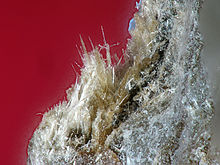- Cummingtonite
-
Cummingtonite 
General Category Inosilicate Chemical formula (Mg,Fe)7Si8O22(OH)2 Strunz classification 09.DE.05 Crystal symmetry Monoclinic 2/m Unit cell a = 9.53 Å, b = 18.23 Å, c = 5.32 Å; β = 101.97°; Z = 2 Identification Color Dark green, brown, gray, beige; colorless to pale green in thin section Crystal habit Rarely as distinct crystals. Columnar to fibrous and granular Crystal system Monoclinic Twinning Simple and lamellar - common Cleavage Good on {110} intersecting at 54 and 126° Fracture Splintery Tenacity Brittle Mohs scale hardness 5 - 6 Luster Vitreous to silky Diaphaneity Translucent, will transmit light on thin edges. Specific gravity 3.1 - 3.6 Optical properties Optically (+) Refractive index nα = 1.639 - 1.671, nβ = 1.647 - 1.689, nγ = 1.664 - 1.708 Birefringence δ = 0.025 - 0.037 Pleochroism With increasing iron content, weak; X = Y = colorless; Z = pale green 2V angle Measured: 65° to 90°, Calculated: 70° to 90° Diagnostic features Characterized by light brown color and needlelike, often radiating habit. difficult to distinguish from anthophyllite or gedrite without optical and/or X-ray tests. References [1][2][3] Cummingtonite is a metamorphic amphibole with the chemical composition (Mg,Fe)7Si8O22(OH)2, magnesium iron silicate hydroxide.
Monoclinic cummingtonite is compositionally similar and polymorphic with orthorhombic anthophyllite, which is a much more common form of magnesium-rich amphibole, the latter being metastable.
Cummingtonite shares few compositional similarities with alkali amphiboles such as arfvedsonite, glaucophane-riebeckite. There is little solubility between these minerals due to different crystal habit and inability of substitution between alkali elements and ferro-magnesian elements within the amphibole structure.
Contents
Name and discovery
Cummingtonite was first discovered in 1824 near the town of Cummington, Massachusetts, and it is from this town that the mineral takes its name.[1][2] It is also found in Sweden, South Africa, Scotland, and New Zealand.
Chemistry
Cummingtonite is a member of the cummingtonite-grunerite solid solution series which ranges from Fe2Mg5Si8O22(OH)2 for cummingtonite to the iron rich grunerite endmember Fe7Si8O22(OH)2. Cummingtonite is used to describe minerals of this formula with between 30 and 70 per cent Fe7Si8O22(OH)2.
Manganese also substitutes for (Fe,Mg) within cummingtonite amphibole, replacing B site atoms. These minerals are found in high-grade metamorphic banded iron formation and form a compositional series between Mn2Mg5Si8O22(OH)2 (tirodite) and Mn2Fe5Si8O22(OH)2 (dannemorite).
Calcium, sodium and potassium concentrations in cummingtonite are low. Cummingtonite tends toward more Ca substitution than related anthophyllite. Similarly, cummingtonite has lower Fe3+ and Al than anthophyllite.
Amosite is a rare asbestiform variety of grunerite that is mined as asbestos only in the eastern part of the Transvaal Province of South Africa. The origin of the name is Amosa, the acronym for the mining company "Asbestos Mines of South Africa."
Occurrence
Cummingtonite is commonly found in metamorphosed magnesium-rich rocks and occurs in amphibolites. Usually it coexists with hornblende or actinolite, magnesium clinochlore chlorite, talc, serpentine-antigorite minerals or metamorphic pyroxene. Magnesium-rich cummingtonite can also coexist with anthophyllite.
Cummingtonite has also been found in some felsic volcanic rocks such as dacites. Manganese rich species can be found in metamorphosed Mn-rich rock units. The grunerite end member is characteristic of the metamorphosed iron formations of the Lake Superior region and the Labrador Trough. With prograde metamorphism cummingtonite and grunerite morph to members of the olivine and pyroxene series.
References
- ^ a b http://rruff.geo.arizona.edu/doclib/hom/cummingtonite.pdf Handbook of Mineralogy, 2001, Mineral Data Pub.
- ^ a b http://www.mindat.org/min-1170.html Mindat data
- ^ http://webmineral.com/data/Cummingtonite.shtml Webmineral data
- Deer W.A., Howie R.A., & Zussman J. An Introduction to the Rock Forming Minerals, 2nd Edition, 1997, pp. 229-247.
- Hurlbut, Cornelius S.; Klein, Cornelis, 1985, Manual of Mineralogy, 20th ed., Wiley, ISBN 0-471-80580-7
- Klein, Cornelius., 2002, The Manual of Mineral Science, 22nd ed., John Wiley & Sons, Inc. ISBN 0-471-25177-1
- Mineral Galleries
Categories:- Amphibole group
- Magnesium minerals
- Iron minerals
- Asbestos
Wikimedia Foundation. 2010.

